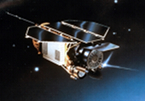 HEAPOW: The End of ROSAT (2011 Oct 24)
HEAPOW: The End of ROSAT (2011 Oct 24)
ROSAT, the Röntgensatellit, was an X-ray satellite observatory, an international collaboration between the Max-Planck-Institut für extraterrestrische Physik (MPE), NASA, The Smithsonian Astrophysical Observatory, and the University of Leicester. ROSAT was launched from Cape Canaveral on June 1, 1990. By January 1991, ROSAT had obtained the first X-ray image of the entire sky. ROSAT was designed to observe the sky in X-rays and in the extreme ultraviolet for three years, but the satellite far exceeded this design requirement. ROSAT made science observations for more than nine years, discovering million-degree gas pervading the Milky Way, finding X-ray emission from comets, studying large reservoirs of normal matter within clusters of galaxies, providing the first detailed views of star formation and stellar activity in young stars, along with detailed measurements of Dark Matter. ROSAT was turned off on February 12, 1999, and since that time had been circling the earth in an increasingly unstable orbit. Finally, ROSAT re-entered the earth's atmosphere sometime between 01:45 to 02:15 Greenwich Mean Time Sunday, October 23 (9:45 p.m. to 10:15 p.m. EDT Saturday, October 22). Up to 30 fragments weighing a total of 1.6 tons could have crashed to the earth's surface at speeds of up to 280 miles per hour. No one knows (yet) precisely where ROSAT landed, though the best guess is somewhere east of Sri Lanka over the Indian Ocean, or over the Andaman Sea off the coast of Myanmar, or further inland in Myanmar or as far inland as China. A sad end to what was truly one of the most productive X-ray satellites ever flown.
MSNBC: Satellite debris could have hit Asia, or the sea
http://asterisk.apod.com/viewtopic.php?f=31&t=25417
| << Previous HEAPOW | High Energy Astrophysics Picture of the Week | Next HEAPOW >> |
